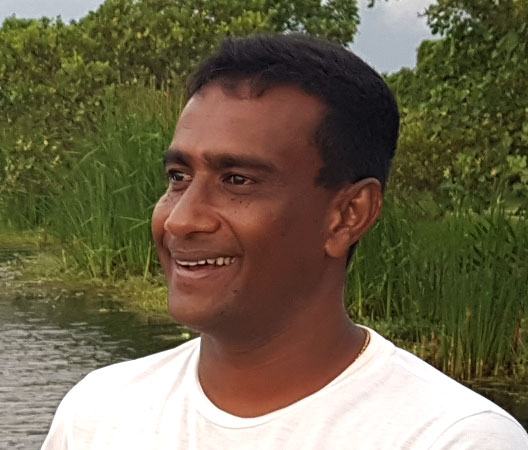About Kalamatiya Bird Sanctuary
Kalametiya is a coastal wetland area that has an especially rich bio-diversity, and is situated on the picturesque southeastern coast of Sri Lanka, in the district of Hambantota. It, along with Rekawa and Ussangoda, forms an area known as “Ruk,” a coastal belt of land of outstanding beauty littered with numerous bays, coves, lagoons, rocky outcrops and sandy beaches, stretching from approximately Tangalle to Hambantota.
Similar to Bundala National Park, another bird sanctuary in Sri Lanka, it has a mix of marine and birdlife, because of its coastal lagoons, mangrove swamps, scrub jungles and open grassy areas.
The reserve originally covered 2500 hectares, but some of which were abolished in 1946 because of the opposition of local residents. In 1984, however, considerably reduced area was declared once again as a sanctuary. Kalametiyawas first recognized as a wildlife sanctuary in 1938.
The Kalametiya lagoon is a brackish water body situated approximately 215 k.m on the Colombo to Tissamaharama road. It lies adjoining the Hungama village and is approximately halfway between the Tangalle and Ambalanntota. Extensive reed beds, forests of Mangrove and other wetland trees and salt marshes fringe this engagingly beautiful lagoon. Its waters are separated from the sea by a narrow strip of beach and only flow out to it through a narrow outlet that periodically closes completely.
The little-visited Kalametiya Bird Sanctuary comprises an area of coastal lagoons and mangroves which is rich in marine and other birdlife, similar to that found in Bundala and best seen from November to March.
The large lakes in the dry zone mostly attract a large number of ducks while the wetlands such as weerawila, kalamatiya and bundala national park are where larger aquatic birds such as stork, heron, egret, spoonbill, pelican, and ibis can be seen. Around mid august a large number of migrant birds arrive in the Island. They are of the species sandpipers, stints, plovers, terns and harriers flying over from North India Siberia, Scandinavia and Western Europe which settle along the lagoons and salterns of the coast areas.
Similar to Bundala National Park, another bird sanctuary in Sri Lanka, it has a mix of marine and birdlife, because of its coastal lagoons, mangrove swamps, scrub jungles and open grassy areas.
The reserve originally covered 2500 hectares, but some of which were abolished in 1946 because of the opposition of local residents. In 1984, however, considerably reduced area was declared once again as a sanctuary. Kalametiyawas first recognized as a wildlife sanctuary in 1938.
The Kalametiya lagoon is a brackish water body situated approximately 215 k.m on the Colombo to Tissamaharama road. It lies adjoining the Hungama village and is approximately halfway between the Tangalle and Ambalanntota. Extensive reed beds, forests of Mangrove and other wetland trees and salt marshes fringe this engagingly beautiful lagoon. Its waters are separated from the sea by a narrow strip of beach and only flow out to it through a narrow outlet that periodically closes completely.
The little-visited Kalametiya Bird Sanctuary comprises an area of coastal lagoons and mangroves which is rich in marine and other birdlife, similar to that found in Bundala and best seen from November to March.
The large lakes in the dry zone mostly attract a large number of ducks while the wetlands such as weerawila, kalamatiya and bundala national park are where larger aquatic birds such as stork, heron, egret, spoonbill, pelican, and ibis can be seen. Around mid august a large number of migrant birds arrive in the Island. They are of the species sandpipers, stints, plovers, terns and harriers flying over from North India Siberia, Scandinavia and Western Europe which settle along the lagoons and salterns of the coast areas.
The presence of lagoons and mangrove swamps, attracts a huge variety of winter migrant birds. It is home to 4 nationally threatened birds, and 38 species of reptiles that are nationally and globally threatened.
This makes the Kalametiya Bird Sanctuary a wonderful place to visit, whether to see the threatened wildlife and birdlife before they become completely extinct, or to show support for their preservation.
This makes the Kalametiya Bird Sanctuary a wonderful place to visit, whether to see the threatened wildlife and birdlife before they become completely extinct, or to show support for their preservation.
Our Story
In year 2008 Mr. Gayan started a first Eco friendly bird watching boat tour in Kalametiya Bird Sanctuary. Our love of the great outdoors and many years of experience has enabled us to develop some of the most exciting adventure and wildlife trips in Kalametiya Bird Sanctuary, Sri Lanka. We now offer an unrivalled selection of suggested itineraries for tours that can be taken as shown or tailor-made, all on dates to suit you.



